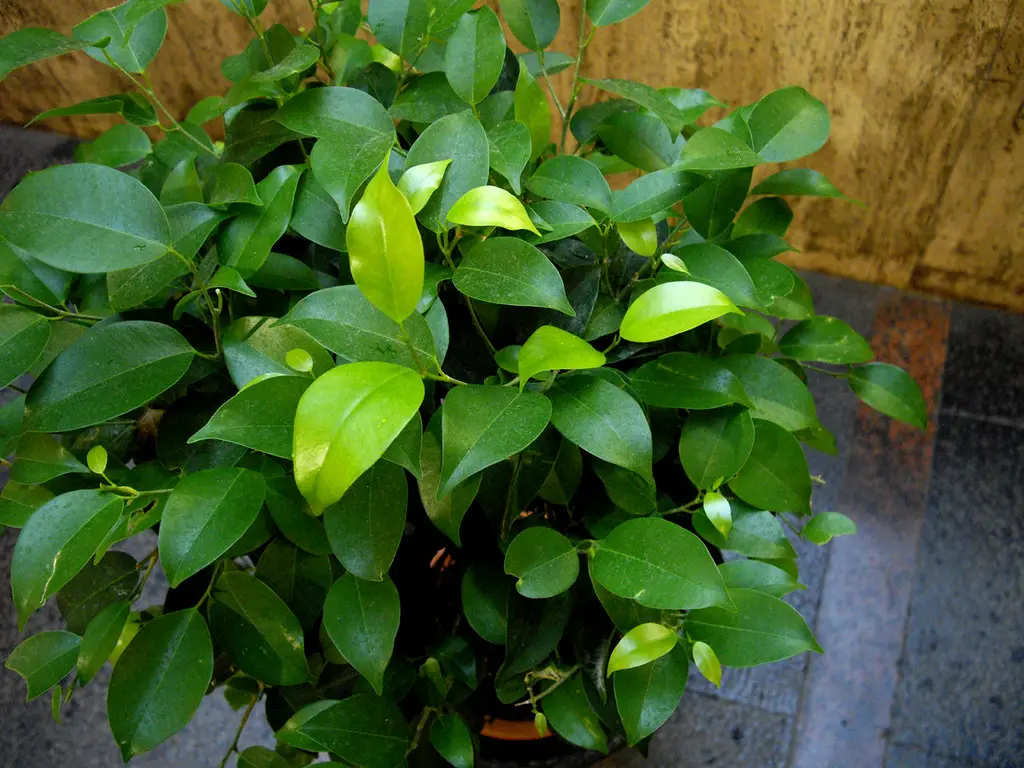Ficus Benjamina, commonly known as the Weeping Fig or Benjamin’s Fig, is a species of flowering plant that belongs to the family Moraceae. Native to Southeast Asia and Northern Australia, this attractive plant is a staple in both homes and offices due to its elegant and glossy green leaves. The Weeping Fig has a graceful, flowing appearance, and its branches droop downward, giving it the name “Weeping.”
Well-loved for its air-purifying qualities, Ficus Benjamina is relatively easy to care for, but it can be sensitive to environmental changes. It is often grown as a houseplant, and with proper care, it can reach impressive heights and become a stunning focal point in interior spaces.
For those who appreciate indoor greenery, Ficus Benjamina offers beauty and elegance along with a connection to nature. Its ability to thrive in a range of light conditions and adapt to different environments makes it a popular choice for plant enthusiasts of all levels.
| Attribute | Details |
|---|---|
| Common Names | Weeping Fig, Benjamin’s Fig |
| Botanical Name | Ficus Benjamina |
| Family | Moraceae |
| Plant Type | Evergreen Tree |
| Mature Size | Up to 60 feet (outdoors), 3-6 feet (indoors) |
| Sun Exposure | Bright, indirect light |
| Soil Type | Well-draining, fertile soil |
| Hardiness Zones | 10-12 |
| Native Area | Southeast Asia, Northern Australia |
Ficus Benjamina Care
Caring for Ficus Benjamina can be quite rewarding, as its glossy leaves and weeping form add elegance to any space. The plant prefers bright, indirect sunlight and a consistently moist soil environment. However, sudden changes in light, temperature, or watering can lead to leaf drop, so a stable environment is crucial for its well-being.
It’s essential to pay attention to the Ficus Benjamina’s specific needs, such as watering when the top inch of soil is dry and providing a humid environment. Regular inspection for pests and prompt treatment will keep the plant healthy and vibrant. Proper care and attention to the unique requirements of Ficus Benjamina will ensure that this beautiful plant thrives.
Light Requirement for Ficus Benjamina
Ficus Benjamina prefers bright, indirect light, although it can adapt to lower light conditions. Placing it near a north or east-facing window with filtered light helps support healthy growth.
Soil Requirements for Ficus Benjamina
A well-draining soil mix with added organic matter is ideal for Ficus Benjamina. A blend of potting soil, perlite, and peat will provide the proper structure and nutrients.
Water Requirements for Ficus Benjamina
Watering when the top inch of soil is dry is suitable for Ficus Benjamina. Overwatering can lead to root rot, so ensuring proper drainage and reducing watering in the winter months is necessary.
Temperature and Humidity
Ficus Benjamina thrives in temperatures between 65-75°F (18-24°C) and appreciates higher humidity levels. Regular misting or a humidity tray can help maintain the required humidity.
Fertilizer
Feeding with a balanced liquid fertilizer every four weeks during the growing season supports the plant’s growth. It’s best to avoid over-fertilizing, as it may cause harm.
Pruning Ficus Benjamina
Regular pruning helps maintain the shape and size of Ficus Benjamina. Removing dead or diseased branches and trimming excessive growth keeps the plant healthy and attractive.
Propagating Ficus Benjamina
Stem cuttings or air layering are common methods for propagating Ficus Benjamina. Using a rooting hormone and providing a humid environment encourages success.
How To Grow Ficus Benjamina From Seed
Growing Ficus Benjamina from seed is a less common method. Fresh seeds can be planted in a well-draining mix, kept consistently moist, and placed in a warm, bright location for germination.
Common Pests & Plant Diseases
Aphids
Regular inspection and treatment with insecticidal soap can manage aphids.
Scale
Scale can be controlled with horticultural oil or neem oil.
Leaf Spot
Avoiding overhead watering and maintaining proper air circulation can prevent leaf spot.
Common Problems With Ficus Benjamina
Leaf Drop
This may occur due to sudden changes in lighting, temperature, or humidity. Maintaining a stable environment helps prevent this issue.
Yellowing Leaves
Overwatering or underwatering can cause yellowing leaves. Adjust watering accordingly.
Weak Growth
Inadequate light or poor soil can lead to weak growth. Ensuring proper light and soil conditions supports healthy development.
Pro Tips
- Keep the plant away from drafts and sudden temperature changes.
- Water when the top inch of soil is dry, and use well-draining soil to prevent overwatering.
- Provide bright, indirect light for best growth.
- Regular pruning maintains the shape and encourages new growth.
- Monitor for pests and treat promptly to keep the plant healthy.




